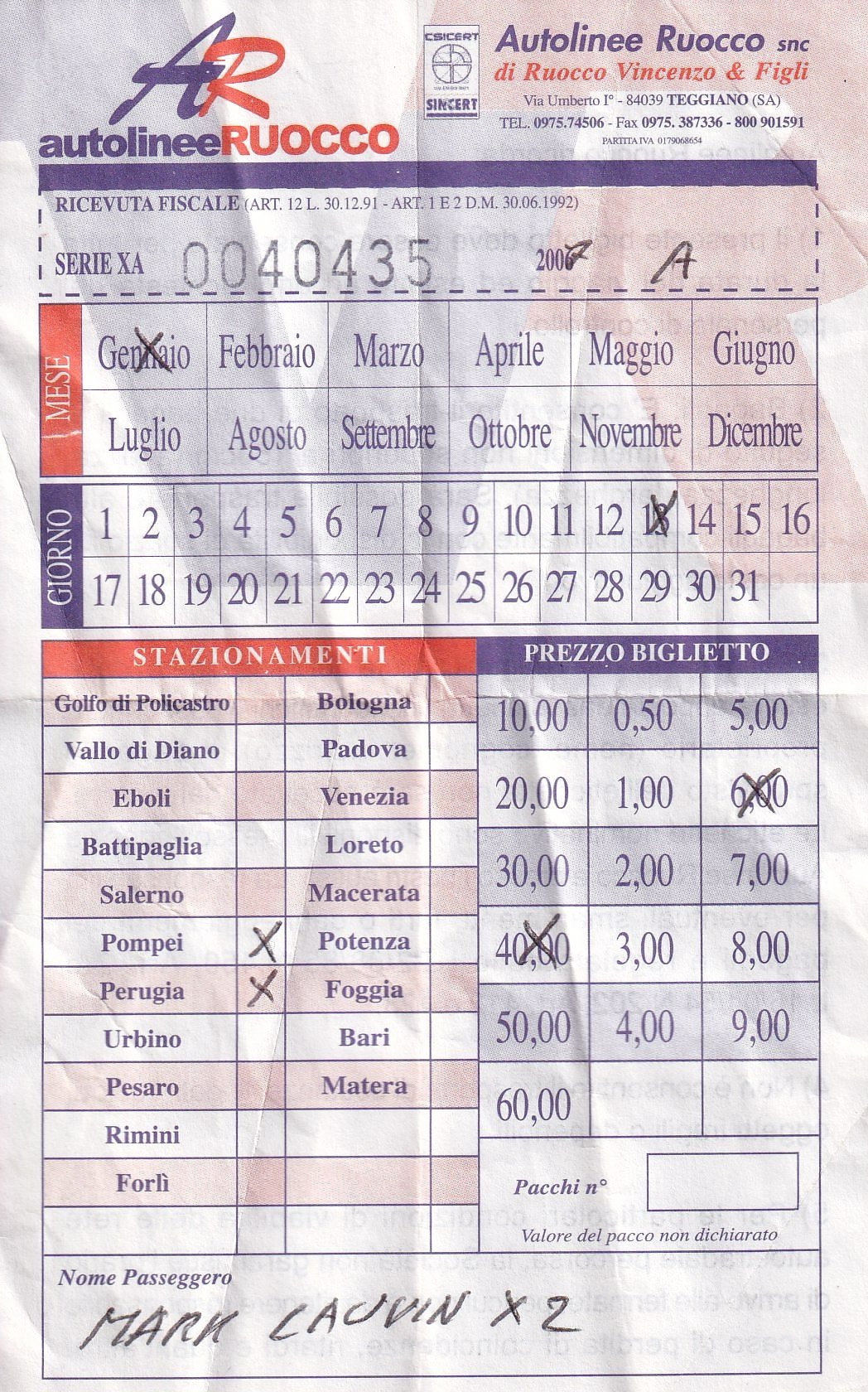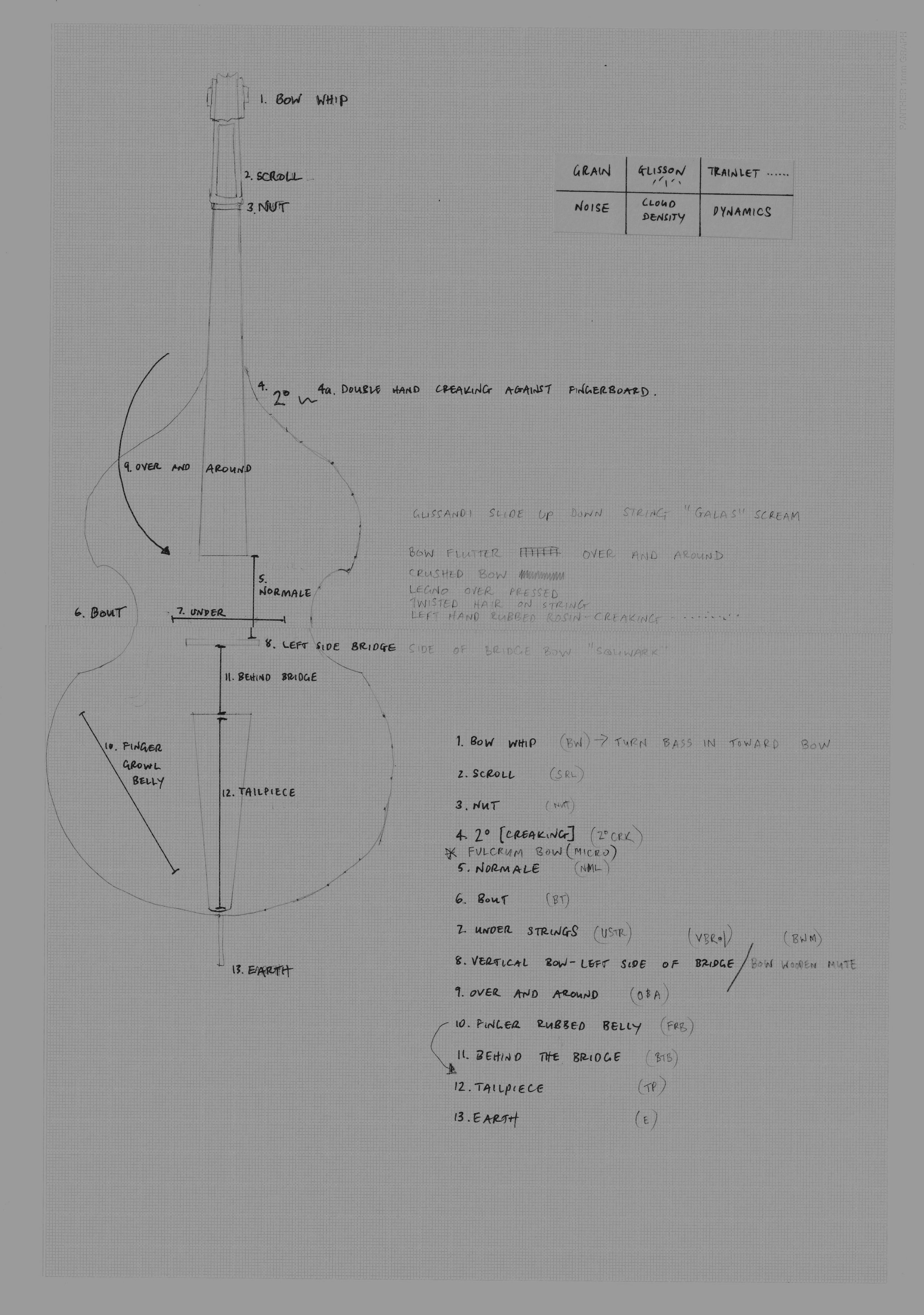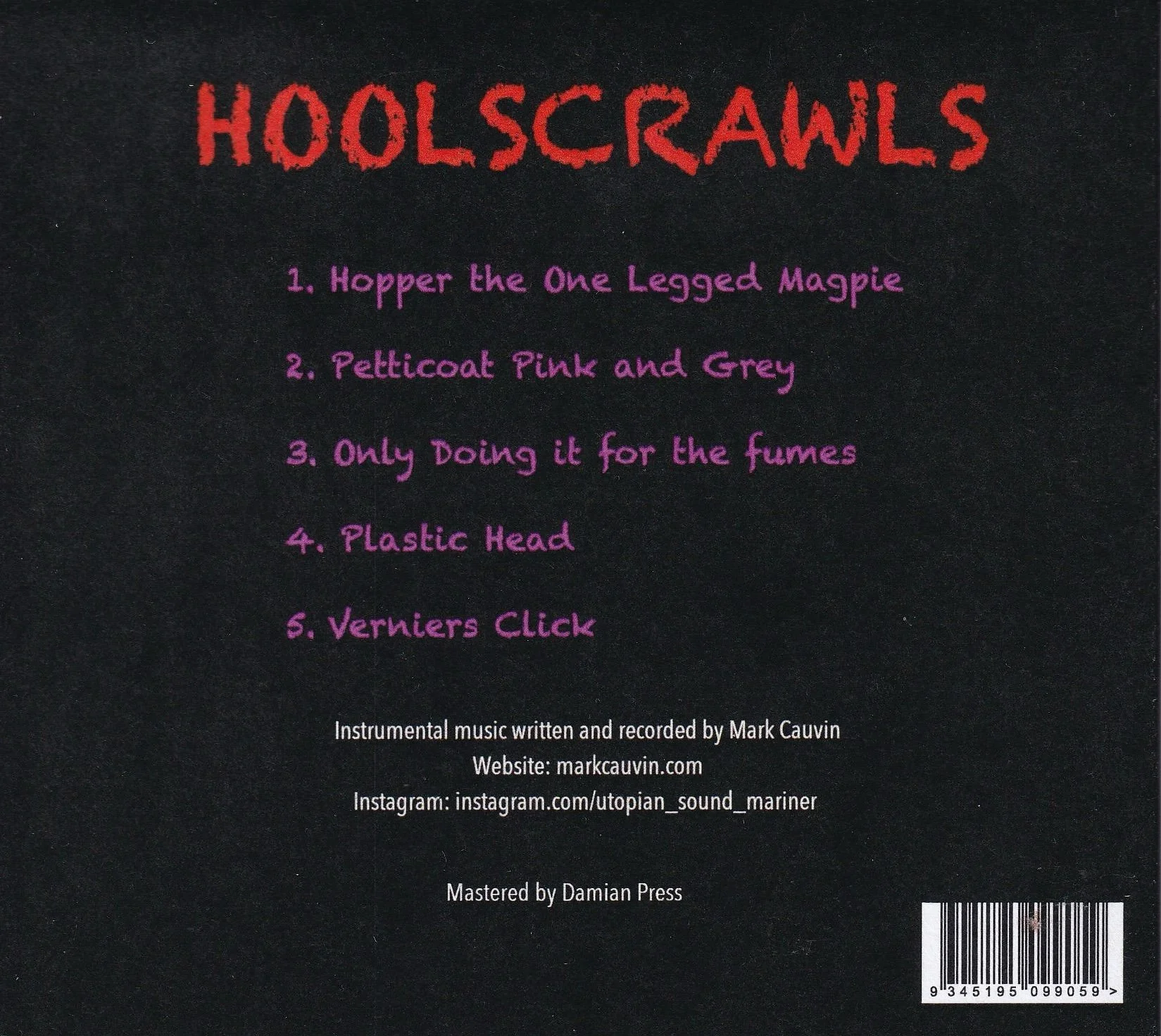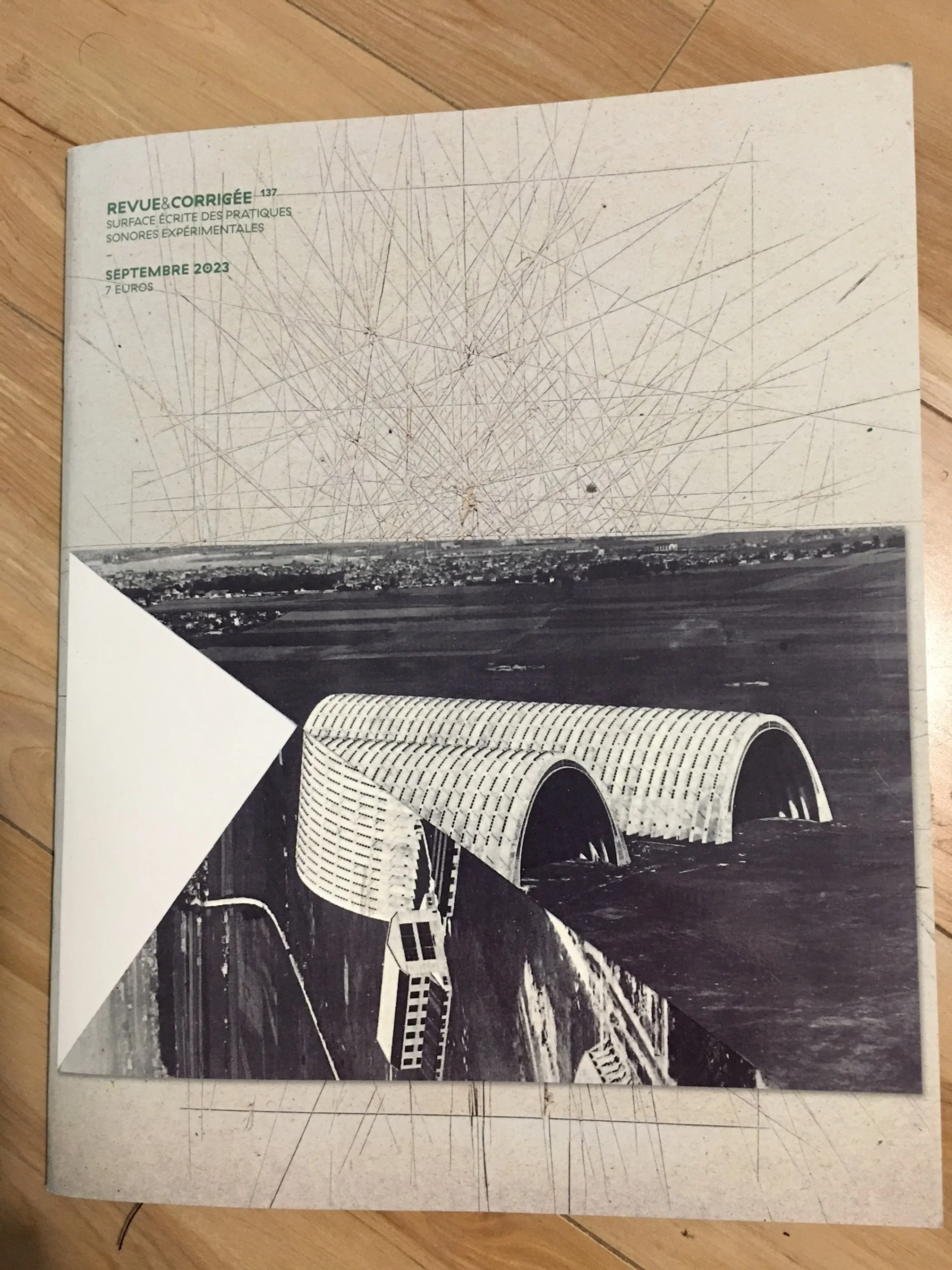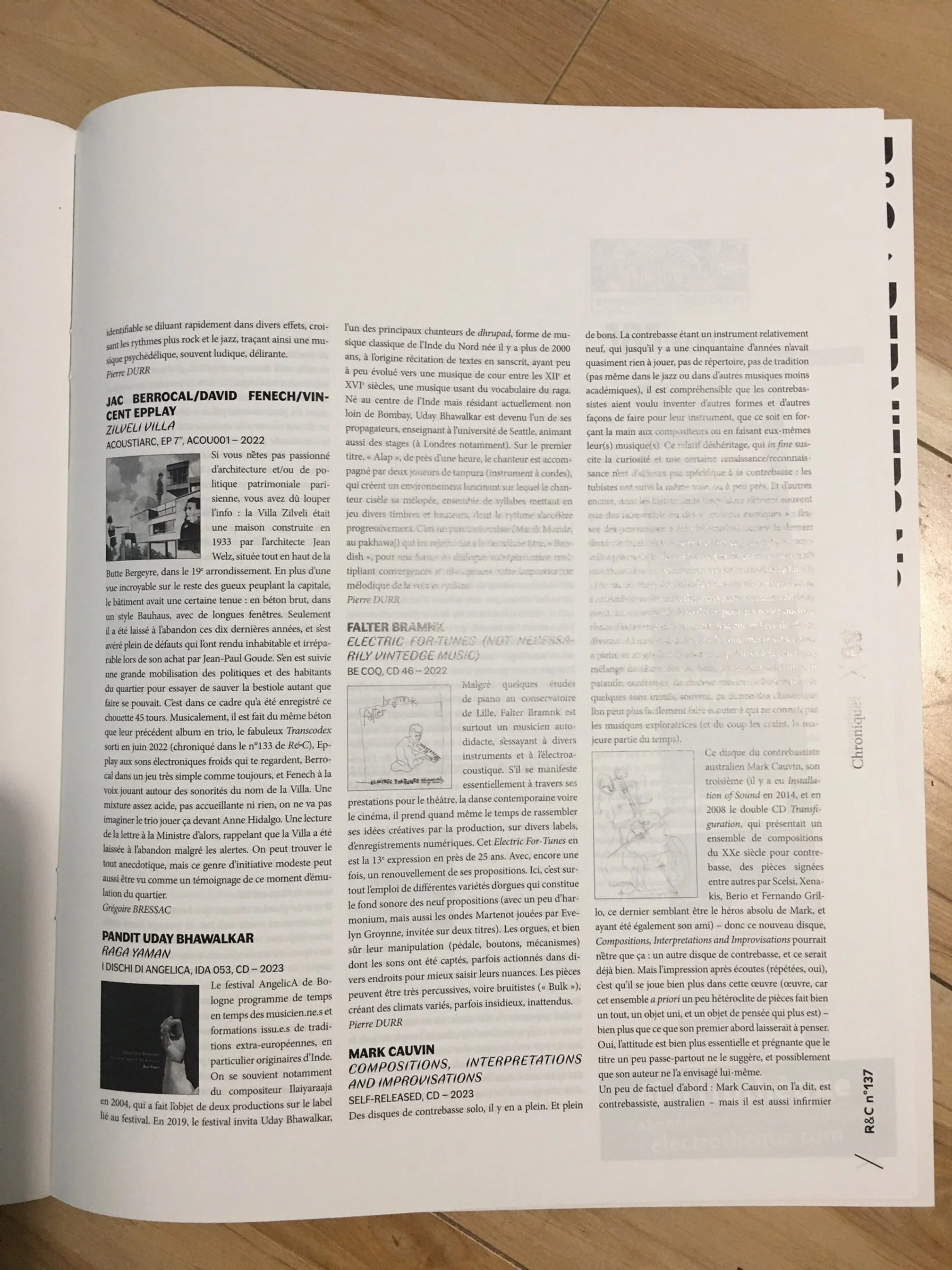There are plenty of solo double bass records out there, and many of them are quite good. The double bass is a relatively new instrument that, until about fifty years ago, had almost nothing to play – no repertoire, no tradition (not even in jazz or other less academic music genres). It's understandable that double bassists wanted to invent new forms and approaches for their instrument, whether by pushing composers to write for it or by creating their own music. This relative lack of heritage, which ultimately sparked curiosity and a certain revival/recognition, is not specific to the double bass. Tubists have followed a similar path, and so have others whose instruments were often seen as mere embellishments or "exotic colors." The resurgence of percussion in the last half-century is a prime example, whereas the violin has gained a few new pieces but has not taken a giant leap or undergone a revolution as the double bass has. The reason being, when you play the violin (or the piano), you have a plethora of music to choose from – and certainly, a considerable burden to bear when trying to offer something different in a field already crowded with masterpieces.
So yes, there are plenty of solo double bass records, and generally, they are very pleasant to listen to. The blend of the wood's resonance, a somewhat cumbersome yet controlled virtuosity, the warmth of the sound as a whole, and the occasional unheard-of sounds often result in something that can be more easily shared with those unfamiliar with exploratory music (and, as a result, often wary of it).
This album by Australian double bassist Mark Cauvin, his third (following "Installation of Sound" in 2014 and the double CD "Transfiguration" in 2008, which featured a collection of 20th-century compositions for double bass, including works by Scelsi, Xenakis, Berio, and Fernando Grillo, the latter appearing to be Mark's absolute hero and also his friend) – so this new album, "Compositions, Interpretations, and Improvisations," could just be that: another double bass album, and that would already be something. However, the impression after repeated listens is that there is much more at play in this work (work, because this seemingly eclectic collection of pieces forms a cohesive whole, a unified object, and, furthermore, an object of thought). Yes, the attitude is far more essential and pervasive than the somewhat generic title suggests, and possibly more than the author himself may have envisioned.
First, let's cover some factual details: Mark Cauvin, as mentioned before, is a double bassist from Australia, but he is also a psychiatric nurse. Although I've never had the opportunity to discuss with him the connections or contributions these two occupations have to each other, they both involve a similar image of "getting to grips with" something, whether it's a human body or an instrument, both of which are substantial and unwieldy (which is why double bassists often refer to their instrument as "the grandmother"). It's about literally taking it on, whether it's the patient or the instrument. For anyone in doubt, I recommend revisiting Joëlle Léandre's "Taxi" – another double bassist who has been grappling with this sonorous beast for years and who embodies a strong and unwavering artistic opinion. Mark is a double bassist but practices in solitude since he doesn't play in groups, contrary to the usual role of a double bassist, which is to be a sideman, an accompanist, the one who "pushes" the soloist throughout the concert before retiring with their massive contraption out of the spotlight. Furthermore, he is rarely heard in those more or less spontaneous duos that seem to be the required way of life for most improvisational double bassists. He most often plays alone, with music he has composed or improvised, or as a solo performer (in the original sense, without accompaniment) of pieces composed by others, such as Cat Hope's excellent solo double bass piece "Dynamic Architecture I." However, he collaborates with artists from other disciplines, such as dance or drawing. This solitary position is well illustrated by his new album, "Compositions, Interpretations, and Improvisations," which contains two compositions by Mark Cauvin, two improvisations, and two pieces by recognized composers who passed away not too long ago, Karlheinz Stockhausen (1928-2007) and Bogusław Schaeffer (1929-2019). His first composition, "Triptych for Double Bass with Electronics," which starts with a noise that Merzbow would not disown, was originally conceived as a concerto. However, Cauvin decided to replace the orchestral accompaniment with the digital projection of drawings created in real-time by visual artist Jody Graham – who, of course, cannot be heard on the album but forms a true duo with the double bassist, "Sound Drawings." What you hear is a mixture of textures, layers of sound, an instrument often impossible to recognize, which could best be described as a blend of acoustic (the warmth of the wood mentioned earlier) and electronic – all created with incredibly limited means, barely two or three guitar pedals, no post-production editing, no fancy electronic processing. What is also evident is an incredible physical energy: you almost feel like you can see the musician in a trance right in front of you. His other composition, "Tape Piece for Double Bass, Noises, and Electronics," is almost the exact opposite: a recording on magnetic tape that has been cut into different lengths and then reassembled, in a different order, of course, creating another continuity. The process, as well as the result, is very acousmatic, very early electronics, immediately reminiscent of the "young Stockhausen," the one who composed his first electronic study in 1953 in a similar way – but with much more precise calculations of pitch and duration ratios (and therefore the lengths of the various tape segments): his Study 1 is often referred to as the "study of a thousand splices." But we will return to the relationship between Cauvin and Stockhausen a little later. The two improvisations, which are formally in the same waters, textures, and densities as his compositions, both focus on the other instrument of the double bass, the bow (yes, many musicians and luthiers indeed consider the bow as a separate instrument, although it is part of the instrument to which they are intended, an example of divided unity, like siamese twins, perhaps). Or rather, they revolve around variations of the bow: in "Motor Bow," it's a mechanical bow with an electric motor, thus an "infinite" bow, created by the maker of experimental instruments, Léo Maurel, which sets off like an earthquake, a long rumble accompanied by high-pitched squeaks – while the bow in "Zip Bow," whose recording comes from an improvisation with Jody Graham, is an invention of Mark himself, who attached a zipper to a bow instead of the usual horsehair bundle. The idea came to him while playing with the zipper on his backpack (zippers and backpacks are also present in the basic materials of "Tape Piece for Double Bass, Noises, and Electronics"). As he himself puts it, the bite that the zipper inflicts on the strings of the instrument is ruthless and damaging to the strings, which cost about 500 Australian dollars, but it produces a unique sound, a sound that is also at the core of the duo with Jody Graham that they titled "Song of the Zip." That covers Mark Cauvin's contributions to the album "Compositions, Interpretations, and Improvisations." Now, let's talk about the other compositions and interpretations, those by Karlheinz Stockhausen and Bogusław Schaeffer: "In Freundschaft" (1977) by the former and the first movement of the "Electronic Symphony" (1969) by the latter. Certainly, just a few years ago, seeing compositions and improvisations focused more on noise than on notes, along with interpretations of composers such as Stockhausen (whom I consider one of the most important of the 20th century, or at least in the top three or five), would have filled me with joy – the joy of seeing these musics being (finally) treated as equals. However, here, the contrast is less favorable: as soon as we enter these two pieces, it feels like a change in light or era, as if we're transported to the past, into a different definition of music perhaps. This is more noticeable in "In Freundschaft" (and it's the first time I've found a Stockhausen composition to sound "dated" or "old-fashioned"), probably because it's a solo piece and strictly acoustic, whereas the double bass electrified in the "Electronic Symphony" appears less outdated. Furthermore, these two "reference" pieces (as they say at contemporary music concerts, where the commission to "young composers" often stipulates building upon a certified masterpiece, a Mozart, a Bach, at the far edge of modernity, a Debussy) are placed right after Cauvin's "Triptych for Double Bass with Electronics," which is undoubtedly the masterpiece of the album, the "Searchlight" of the project – this powerful spotlight of the DCA that war pilots called "The White Finger." Perhaps a different arrangement of the pieces would have mitigated this sense of a rupture, a return to the past... But let me immediately clarify that the issue is not with Cauvin's interpretation, which is quite impeccable – in fact, his version of "In Freundschaft" was endorsed by Kathinka Pasveer, Stockhausen's historic interpreter and, in a way, the guardian of his musical legacy, especially through the "Stockhausen Courses for New Music" in Kürten, a village near Cologne, where the master lived. The issue (if it can even be called one, but I perceive it more as incredibly good news) is that contemporary music and its protagonists (with Mark Cauvin being one of its major players) no longer need to be measured against music from the past, even if that past is relatively recent. Finally, contemporary music has matured and gained independence from the criteria of value and methods of the past. Consequently, music conceived and performed in 2022 or 2023 may seem more current, more "contemporary," than compositions from 1969 or 1977, which are nearly half a century old. It's no longer surprising; we are simply shifting from a museum-like perspective to a vision of the present day.
There is a strong possibility that Mark Cauvin did not consciously intend to mark this transition, this difference in eras. We have mentioned his attachment to contemporary repertoire, a certain idea and respect for what is called contemporary music, and we have cited the names of Scelsi, Xenakis, Stockhausen, noting the influence of Grillo (who was among the first to give the double bass a prominent role). Furthermore, it is perhaps with him that I have had the deepest discussions about what it means, or should mean, to "interpret" another composer's composition. If we were to draw parallels with the masters of the past, we could say that Mark Cauvin faced a similar moral obligation and dilemma as Arnold Schönberg did more than a century ago (in the early 1900s). Schönberg, initially an ardent admirer of Wagner, Strauss, and Brahms, felt historically compelled to move away from tonal music and develop atonal serial music because it more accurately reflected the times, even though he was fearful of abolishing the organizing principles he believed were necessary, fearing that "sonic chaos" would replace the structured tonality. With this album, "Compositions, Interpretations, and Improvisations," it is possible that Mark Cauvin has taken a similar step, achieved a similar advancement, and further explored our present.
Kasper T. TOEPLITZ

